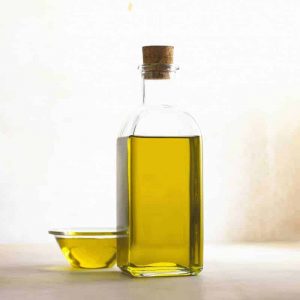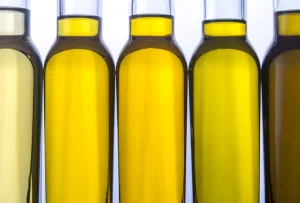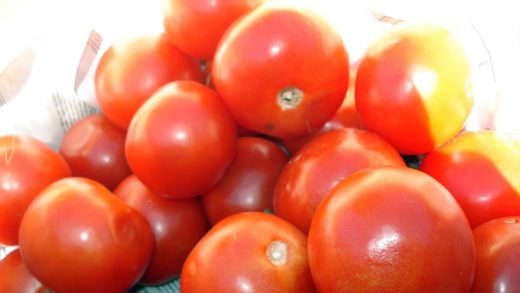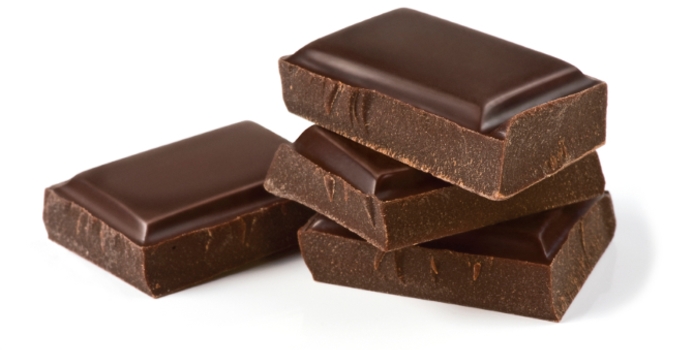Have you ever watched the TV show CSI, Crime Scene Investigation? It’s about using science to catch criminals. Well, those techniques are also being used to learn about what’s really in your food. The researchers at the University of California at Davis have a food CSI laboratory. And they’ve been looking at olive oils. Their findings show that there probably are some crimes being committed out there.
Basically, there are three kinds of olive oil: Extra Virgin, Virgin, and just plain olive oil. Each of these designations indicates not just quality but how the olives were processed. However, in the United States, there are no regulations about what constitutes Extra Virgin from any other olive oil.
Let’s look at how olives are pressed to extract their oil. First, the olives are washed and inspected for bad and unripe olives. Olives are crushed into a paste between millstones or steel drums, just like in the old grain mills. The paste is then placed on mesh screens, much like what you have in your windows right now, but a little finer. A stack of these screens is built up and then the whole thing is wheeled under a press. At the bottom of the stack is a spout leading to a hole in the floor or some sort of catching device. As pressure is applied to the screens, the olive paste, or pomace, gives up the oil, which runs into the collector.
This method is also called “cold press,” because no heat is used to help extract the oil from the olives. This is extra virgin or virgin olive oil. Extra virgin means the oil comes from a cold press and is the first pressing of the olives. The oil produced in this method will have a very floral smell and tangy, fruity taste. You should note that this is a taste that is not neutral and will easily overpower some foods. Also, extra virgin olive oil doesn’t do well in high heat over a long time. For quick sautéing, it is great, especially if you want that taste that comes from only this oil. Extra virgin olive oil is best for salad dressings and as a condiment.
The second method is used to produce regular or plain, refined oil.
A corkscrew shaft inside a heated cylinder smashes the olives or pomace up against plates inside the press. This extracts more oil than the cold, flat press, but the quality isn’t as good. This method is often used using the crushed olives from the first method in order to extract absolutely everything they can from the olives. This oil is then strained and refined to mellow the flavor and remove impurities. Virgin or plain olive oil is good for all kinds of uses and can handle high heat. But it also has less flavor.
In both cases, the oil is then strained and filtered. Sometimes at this point, it will go right into bottles. But in some cases, the oil will go into large holding tanks to be mixed with oils from other olives, different pressings, or even other kinds of oil, like rapeseed or corn oil.
Sometimes you can tell the differences by looking at them. Extra virgin olive oil often has a greenish cast, rather than a yellow or amber color found with most other vegetable oils. Tasting will sometimes help ensure you’re getting quality, but not always. Blended oils can often have a less intense olive flavor, but still taste a bit like extra virgin.
When shopping for extra virgin olive oil, always make sure the label says “cold pressed.” That’s the only real indicator you have. That part is regulated, while quality is not. The brand does matter, but even expensive brands can be fooling you.
That was the conclusion of the UC-Davis study. Most of the oils that were tested were not pure extra virgin olive oil. In fact, two-thirds of the imported extra virgin olive oils tested failed to make the grade. The lab found that much of the oil on the market is oxidized, meaning it is turning rancid. They found some bottles labeled olive oil was actually a blend of olive and soybean or other oils based on tests for specific fatty acids in the oil. Naturally, the people who sell olive oil have disputed the tests, saying they are untried and unproven.
But things may be changing. The US Department of Agriculture is considering more stringent labeling requirements in addition to more random testing of oils to meet international standards.
Well-known brands are not always the best solution. Nor is buying the expensive, specialty store brands. Many of those found on your grocery store shelves are good quality at a reasonable price. Look for “cold pressed,” slightly greenish color, and oil that’s not too thin.






